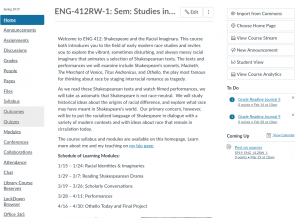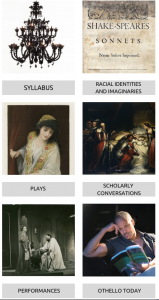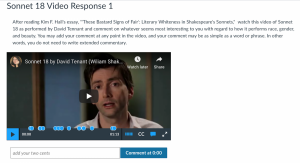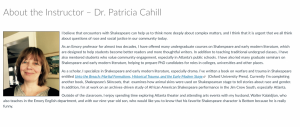This article is part of a series featuring faculty who participated in the Teaching with Canvas 2018 cohort.
Dr. Patricia Cahill, professor of English, had the challenging task of creating an entirely new course – a seminar on the topic of Shakespeare and Race – during her participation in Teaching with Canvas. This course would be on the small side with an expected head count of 10-15 students and focused on readings, media, and related discussions. Dr. Cahill wanted the Canvas course to be highly interactive and incorporate a variety of weekly assignments, with a capstone project at the end to show students’ understanding of the material.
Dr. Cahill’s Teaching with Canvas Goals
Before participating in the 2018 Teaching with Canvas cohort, Dr. Cahill used Canvas for syllabi, discussions, and readings. She applied to the program hoping to explore the possibilities for online writing workshops and the ability to have students respond to their own work and that of their peers. She also wanted to embed Shakespeare-related audio and video into her syllabus and discussion posts.
In other courses, she had students curate and share digital exhibits using Google Docs. Dr. Cahill was interested in exploring another way for students to present a digital exhibit that would ask them to address historical contexts for understanding race and Shakespeare.
Outcomes from the Program
Through a series of exercises, Dr. Cahill and I worked together to define learning objectives and build out modules for her new course. We designed five main modules and presented them in a clean, straightforward homepage (see screenshots below.) To personalize her Canvas course, she included a bio page introducing herself.
We decided to use Arc, a video tool native to Canvas that TLT is piloting, to incorporate video and discussion into the course. Students were asked to respond to several videos about Shakespeare, which they could do directly in the Arc tool and it counted toward their participation grade. They also used Arc to make their own introduction videos at the beginning of the course.
In addition to plenty of discussion posts, students were also asked to do regular journaling assignments in Canvas to reflect on readings, video, and audio and to complete two essay assignments. For the final project, students could now choose to present their online exhibit on WordPress instead of Google Docs with pedagogically support for the blogging platform from TLT.
ENG412WR: Shakespeare and Race Showcase


Homepage for Shakespeare and Race. The top of the homepage gives a brief summary and outline of the course and the six menu images below that link to the syllabus and modules.

An example of a discussion assignment using Arc that allows students to make comments on videos in real time. Students watch the video and then put their comments into the text box. They can comment multiple times while watching the video and see other students’ responses.

Dr. Cahill’s instructor bio page. These pages make instructors more relatable to students.
Reflecting on the TwC Experience: An Interview with Dr. Patricia Cahill
Q: How did the TwC program improve or otherwise change your use of Canvas?
Dr. Cahill: It encouraged me to try tools I’ve never before tried in class for literary / performance analysis such as ARC ( which was very popular with students) and, more generally, it encouraged me to conceptualize my course via the canvas module rather than in a more linear way. It also encouraged me to be more intentional in scaffolding my assignments.
Q: What was the most challenging part of the program? What was the most rewarding?
Dr. Cahill: The most challenging part of the program was the fact that I was not simply tweaking a course I had already taught! rather, I had signed up to create a canvas course site for a course that did not yet exist. While this was enormously rewarding—it allowed me to think capaciously about the ways I might teach the course—it also made things more complex because they’re always a lot of options! Because I think and read a lot about pedagogy, I also found It incredibly fun to talk with both educational analysts and other faculty about my pedagogical goals and challenges.
Q: What are your future goals with Canvas going forward?
Dr. Cahill: I want to explore more canvas and canvas-friendly tools I’ve heard about and I want to get better at some basic ones I currently use.
Now Accepting Applications for Teaching with Canvas
Applications for the second Teaching with Canvas cohort are now open! Teaching with Canvas aims to provide Emory faculty with a supportive and shared experience while they explore how thoughtful Canvas course design supports instructional strategies such as student interaction, communication, collaboration, and field work. Applications are due April 3. Click here to learn more, including how to apply.
Header image by Paweł Czerwiński on Unsplash
